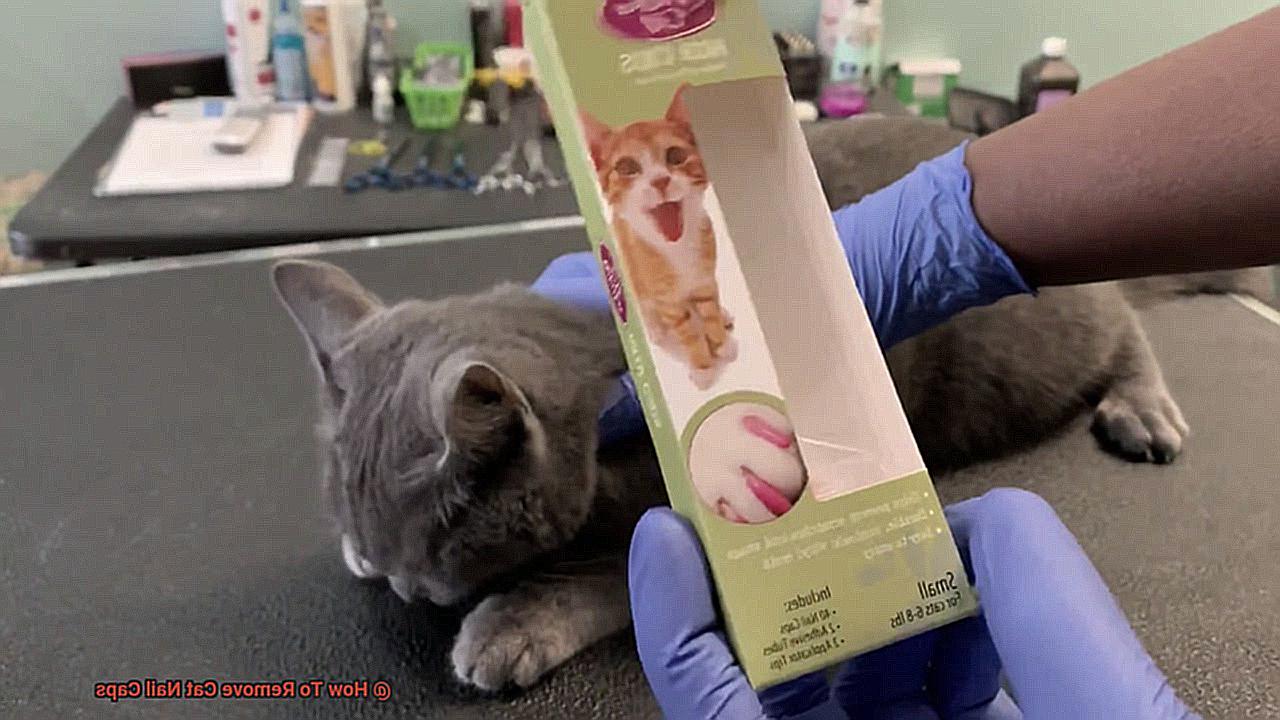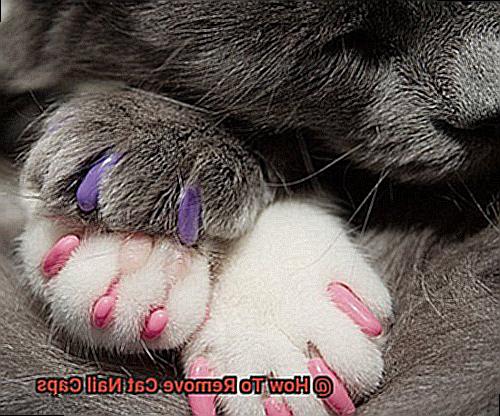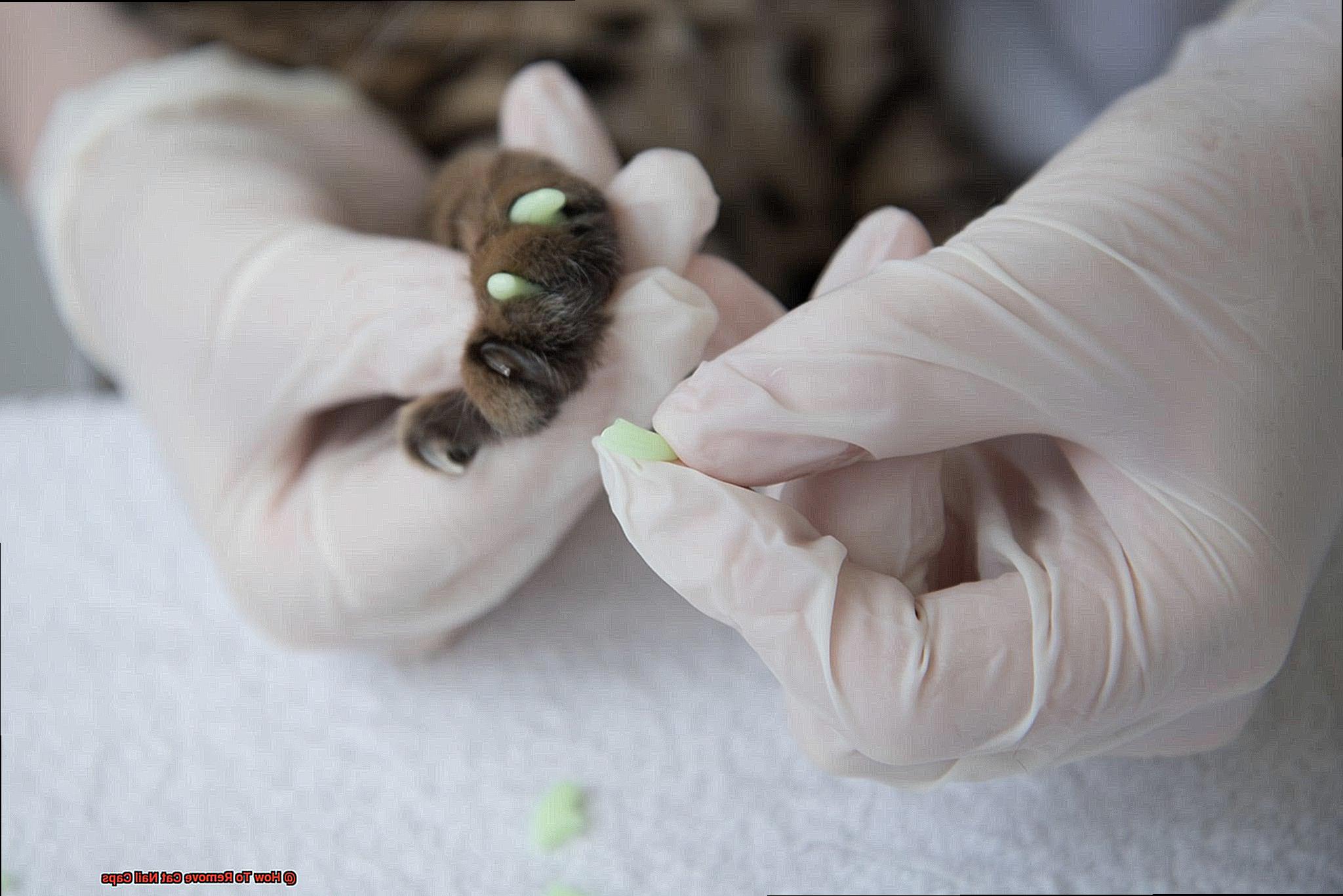Are your cats’ claws too sharp?
Thinking of using nail caps to protect your furniture and skin from scratches? You’ve come to the right place.
Nail caps are a safe and convenient way to control your cat’s claws. They’re a smart way to avoid having to trim their nails every month.
But how do you remove them when it’s time? In this blog post, we’ll tell you exactly how to remove cat nail caps safely and effectively.

We’ll guide you through each step, including when it’s time for removal, what items you need, and tips on making the process stress-free for both of you. Plus, we’ll discuss the dangers of removal and how to avoid them.
So if you want to know how to properly remove cat nail caps, read on. Here you’ll find all the details you need.
Keep your cats’ claws clean and safe with our help.
What are Cat Nail Caps?

Cat nail caps are a great solution for cat owners who want to protect their furniture, floors, and walls from their pet’s scratching.
These small caps fit snugly over the claws of cats, providing a safe barrier between your beloved pet and your home. Not only do they protect surfaces from damage, but they can also help prevent injuries caused by excessive scratching.
But what is the best way to remove them? Removing cat nail caps requires patience and care to ensure that your furry friend doesn’t experience any pain or discomfort.
Start by making sure your cat is relaxed and comfortable; you may need someone else to distract them with treats or toys. To trim the cap, use a pair of cat claw clippers and apply light pressure to the sides of the cap to loosen the adhesive.
This will allow you to gently pull it off without causing pain or damaging your cat’s underlying nail. If it is still attached, do not force it off as this can lead to injury; let it come naturally as the adhesive fades over time.
In some cases, cats may not tolerate this procedure, so it may be beneficial to seek advice from a veterinarian or groomer for more effective removal. Additionally, if you find that the caps are falling off too early or causing discomfort, consider switching brands or sizes of nail caps for a better fit on your cat’s claws.
However, it is essential to choose the right size and quality and check them frequently to ensure they’re not causing any discomfort to the cat.
Why Do Cats Need Nail Caps?
Cat claws are essential for marking their territory, keeping them sharp and healthy.
Unfortunately, this can lead to unwanted scratching of furniture, carpets, and other household items. To protect both the cat and their environment, many pet owners are turning to a humane solution: cat nail caps.

Nail caps provide a protective barrier that prevents cats from accidentally injuring themselves or others by scratching too aggressively or getting their nails caught in fabrics.

Additionally, they can be beneficial for cats with certain medical conditions or sensitivities; such as allergies or skin conditions that may cause them to scratch excessively and develop painful abrasions or infections.
However, it is important to remove and replace them every few weeks in order to ensure the cat’s health and comfort.
Preparing to Remove Cat Nail Caps
You might be familiar with the wonders of cat nail caps.
They can help protect your furniture and floors from scratches, as well as keep your cat’s claws clean and sharp. However, it’s still important to check in on your cat every few weeks to ensure their safety and wellbeing.
When it comes time to remove their nail caps, don’t worry – you can make it a safe and stress-free experience for both you and your furry friend. Gather the necessary tools: a pair of cat nail clippers, a cotton ball or gauze, and some nail polish remover.
It’s important to note that nail caps should only be removed if they are loose or if they have been on for the recommended amount of time (usually around 4-6 weeks). Before attempting to remove the nail caps, spend some time getting your cat used to having their paws touched and handled.
This can be done by gently massaging their paws, playing with their toes, and offering treats as positive reinforcement. When ready to remove the nail caps, start by gently pressing down on the cat’s paw to expose the nail.
Use your cat nail clippers to carefully cut through the cap, being careful not to clip the actual nail. If the nail cap is still firmly attached, apply a small amount of nail polish remover to a cotton ball or gauze and hold it against the cap for a few seconds.
Trimming the End of the Nail Cap
Trimming the end of a cat nail cap is an important task to ensure your feline friend’s health and safety.
With the right tools and technique, you can trim their nails without causing any pain or injury.
Gather your supplies: pet-specific clippers or scissors, a nail file, and some treats for your cat.
Have someone hold or distract your feline friend with toys or treats while you work on their nails.
Then, locate the nail cap and make a small snip at the very end with the clippers or scissors.
Be sure not to cut too much of their natural nail as this could cause pain and bleeding. If you need to achieve a certain length, continue trimming small pieces until you reach it.

After trimming any excess length from your cat’s nail caps, use a nail file to smooth out rough edges.
Applying Pressure to Loosen the Adhesive
Removing your cat’s nail caps can be a tricky task, but with the right strategy and equipment, you can do it without causing any discomfort or injury.
Applying pressure to loosen the adhesive is an essential step in this process. To start, gently squeeze your cat’s paw and hold it still while you firmly grip the nail cap with a pair of pliers or scissors.
Make sure not to press too hard or apply too much pressure, as this can lead to pain or injury. Once you have a secure grip on the nail cap, twist and pull it off slowly and carefully.
If the glue is still too strong, use a cotton swab or cotton ball soaked in rubbing alcohol or nail polish remover to loosen it. It’s important to remember that you should never use excessive force or pull the nail cap off strongly enough as this could damage your cat’s claw or cause injury.

Gently Pulling off the Nail Cap
Removing your cat’s nail caps can be a tricky task, but with the right approach, it can be done safely and effectively.
The key is to take your time and use gentle pressure when pulling off the cap. Before attempting to remove the nail cap, make sure your cat is calm and relaxed.
Hold their paw firmly but gently, and check the nail cap to see if it’s loose enough to come off without too much force. If it’s stuck, try soaking their paw in warm water for a few minutes to loosen the adhesive.
Once you’re ready to take off the nail cap, use a pair of tweezers or your fingers to carefully grasp the edge of the cap and slowly pull it away from your cat’s claw. It’s important not to pull too hard or too quickly as this could cause discomfort or pain for your cat.
When to Seek Professional Assistance
Removing nail caps from your beloved feline can be a tricky process, but it’s essential to do every few weeks as the caps naturally fall off.
Knowing when to seek professional assistance is key for a safe and successful removal experience. If you feel uncomfortable or uncertain about taking off the caps yourself, or if your cat is being uncooperative, it’s best to bring them to the vet or groomer for help.
Additionally, if you notice any redness, swelling, or discharge around the nail or paw area, seek immediate veterinary advice as this could indicate an underlying infection. When it comes to your pet’s health and safety, it’s always better to be cautious.
Professional groomers and veterinarians have the expertise and experience needed for a safe and stress-free removal procedure.
gzJ7wImpg04″ >
Alternatives for a Better Fit
It can be disheartening when your cat isn’t comfortable wearing nail caps, despite proper application.
Thankfully, there are other solutions available to provide a better fit for your feline companion. Nail trimming is an effective alternative that can help keep your cat’s claws short and prevent any damage to home surfaces.
It’s important to note that some cats may resist trimming, so it should be done with caution and care to avoid hurting the animal. Soft paws are also an option for cats with sensitive paws.
These are similar to traditional nail caps but they are made from a softer material that is designed to fit the natural curve of a cat’s claws. They come in various sizes and colors, and they can be applied in a similar way as traditional nail caps.
Lastly, offering scratching posts or pads is another great way to fulfill your cat’s natural urge to scratch while keeping their nails healthy. Scratching posts come in many forms – such as corrugated cardboard, sisal rope, or carpet – so you can experiment with different materials until you find one that works best for your cat’s needs.
Overall, there are plenty of alternatives available for pet owners looking for a comfortable and safe solution for their cats’ nails.
Also Read: How To Remove Cat Claw Sheath
Conclusion
Removing cat nail caps can be a tricky task, but it doesn’t have to be daunting.
With the right supplies and techniques in hand, you can safely and efficiently remove them. Start by ensuring your cat is relaxed and comfortable; if not, enlist someone else to provide treats or toys as a distraction.
To loosen the glue, use two pair of cat claw clippers and apply light pressure to the cap’s sides. This will help you take off the cap without pain or damaging your cat’s underlying nail.
If it’s still attached, don’t force it off; let it come off naturally as the adhesive fades over time. Once removed, use pet-specific clippers or scissors to trim any excess length.
If the caps are falling off too soon or causing discomfort, consider switching brands or sizes for a better fit on your cat’s claws.







